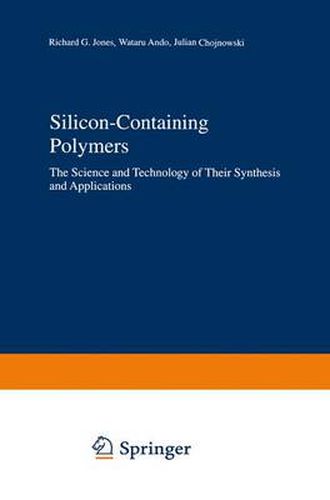Readings Newsletter
Become a Readings Member to make your shopping experience even easier.
Sign in or sign up for free!
You’re not far away from qualifying for FREE standard shipping within Australia
You’ve qualified for FREE standard shipping within Australia
The cart is loading…






This title is printed to order. This book may have been self-published. If so, we cannot guarantee the quality of the content. In the main most books will have gone through the editing process however some may not. We therefore suggest that you be aware of this before ordering this book. If in doubt check either the author or publisher’s details as we are unable to accept any returns unless they are faulty. Please contact us if you have any questions.
BACKGROUND Polysiloxanes have chains constructed of alternately arranged silicon and oxygen atoms with organic groups attached to the silicon atoms. This structure gives them a unique combination of properties that hold great interest for a host of practical applications. Although they have been known and manufactured for many years, their applications continue to expand rapidly and this boosts progress in the generation of new and modified polysiloxanes. Polysiloxanes constitute the oldf’ ‘ known class of silicon-based polymers and the broadest one when viewed in terms of the variety of structures differing in topology and the constitution of organic substituents. There are also many and various types of siloxane copolymers, some of purely siloxane structure and others of siloxane-organic composition. There is no doubt that polysiloxanes are the most technologically important silicon-based polymers. The broad class of model materials known as silicones is based on polysiloxanes. They are also the best known, as most research in the area of silicon polymers has for many years been directed towards the synthesis of new polysiloxanes, to understanding their properties and to extending their applications.
$9.00 standard shipping within Australia
FREE standard shipping within Australia for orders over $100.00
Express & International shipping calculated at checkout
This title is printed to order. This book may have been self-published. If so, we cannot guarantee the quality of the content. In the main most books will have gone through the editing process however some may not. We therefore suggest that you be aware of this before ordering this book. If in doubt check either the author or publisher’s details as we are unable to accept any returns unless they are faulty. Please contact us if you have any questions.
BACKGROUND Polysiloxanes have chains constructed of alternately arranged silicon and oxygen atoms with organic groups attached to the silicon atoms. This structure gives them a unique combination of properties that hold great interest for a host of practical applications. Although they have been known and manufactured for many years, their applications continue to expand rapidly and this boosts progress in the generation of new and modified polysiloxanes. Polysiloxanes constitute the oldf’ ‘ known class of silicon-based polymers and the broadest one when viewed in terms of the variety of structures differing in topology and the constitution of organic substituents. There are also many and various types of siloxane copolymers, some of purely siloxane structure and others of siloxane-organic composition. There is no doubt that polysiloxanes are the most technologically important silicon-based polymers. The broad class of model materials known as silicones is based on polysiloxanes. They are also the best known, as most research in the area of silicon polymers has for many years been directed towards the synthesis of new polysiloxanes, to understanding their properties and to extending their applications.